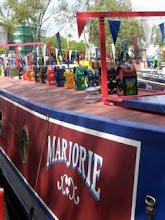I need to go home. To London, that is. When I return there, I will be getting things ready to move from our old flat on Abbey Road to our new one just a few streets away. This process seems daunting, although when compared to our move of last year, from Belmont to London, it should technically be a piece of cake.
It should also be a walk in the park compared to the construction project that has been going on in the basement of our Belmont home, where I have been residing for the past month.
We arrived in Boston on June 15th, shortly after TeenE’s school year ended in London. Since then she has been visiting with friends and preparing for her four weeks at adventure camp in New Hampshire. I have been visiting friends and spending a lot of time in our basement.
The first two weeks we were here, it rained almost every day. Monsoon-like conditions soaked the ground and raised the water table enough that the basement walls were damp enough to grow plants suitable for the forest floor. This has been a problem for this house since before we moved in, and the former owners installed a French drain and a drywell in the backyard. The barn-board paneling, installed perhaps in the 1960’s, as well as the wood lathing holding it out from the wall had been slowly rotting and molding since then.
Last summer, as reported on this blog, with the help of many friends, I took down the paneling in the north corner of the basement, waterproofed that area of the wall, and installed ceramic tiles. This summer, the entire northeastern walls were rehabilitated. Using a crowbar, I removed the punky paneling from the floor to about three feet above, including molding strips between four and ten feet long. I scraped the wall down, removing decades of loose paint and plaster. I used a chisel to loosen areas of failing cement and discovered that some of the wooden molding had been placed directly on top of a row of cinder blocks. The holes of the blocks were just sitting open, inviting incursion by rodents and snakes. No wonder the cats always liked the basement!
The next step was using hydraulic cement to waterproof the wall’s surface. For those of you not “in the know”, hydraulic cement is a quick-drying product which uses what I presume to be a chemical reaction producing heat to transform the cement powder and water mixture into a rock-hard, impermeable surface in about three minutes. One has about thirty seconds to stir one scoop of water into three scoops of cement powder, producing a goo the consistency of cake icing. Application to the intended surface has to happen within the next two minutes. If this does not happen, the entire batch hardens into a rock in the bottom of the plastic pail and must be discarded. Note: do not attempt to answer the doorbell when working with hydraulic cement, especially if it is the UPS delivery truck with a package you have ordered on Son’s behalf as a birthday gift to the woman you are not allowed to refer to as his “girlfriend”. You will certainly have to knock the now-hardened magma out of the bucket and begin again.
After what will seem like thirty separate trips to the laundry sink to mix up the cement, step back and watch your wall be transformed into a less damp, more leak-proof surface.
The next step in Wall Rehab is to make several trips to the store which sells home maintenance and repair supplies. On the first trip, purchase enough supplies to cover the square footage of the wall so you can avoid a second trip. If you are using ceramic tiles and acrylic tile adhesive, buy just enough tiles to cover the surface, but twice as much adhesive as you think you’ll need. Also purchase pre-colored, pre-mixed grout, some trowels, tile spacers, and a “grout float” which helps you push the grout into to spaces between the tiles.
Now, once the weather clears and the basement is less damp, spend all the sunny days of your "vacation" in the basement. It will help to make a big pot of coffee at the beginning of each day so that you can provide yourself with endless refills of iced coffee. It will also help to bring a radio or other music-broadcasting device into the basement with you. A live radio broadcast will help you know what time of day it is, as the conditions in the basement will not be conducive to knowing the hour of the day or the day of the week. Playing your favorite genre of “music for home repair”, in my case, Classic Rock, will help to energize you and imbue your work with the “vibes” of the music. Turn the music UP when the vibes are good for you, for example, Pink Floyd’s THE WALL, any Led Zeppelin, or Beatles. Turn the music OFF when the vibes are not good for your project, such as anything by Black Sabbath or “Don’t Fear the Reaper” by Blue Oyster Cult. (Although I do like the message of this song, it was a little too… evocative of a grim mood… for me to be fully operational.)
Once the proper musical mood has been achieved, carefully place the ceramic tiles in a pleasing and efficient pattern using the tile spacers and acrylic adhesive. Use a level to make sure your horizontal lines stay horizontal, and that your vertical stacks don’t go off-center. This last step may mean you’re your tile-gluing job takes several days. Once you have achieved your tile results, take one day off while you allow the adhesive to cure. Next, using a trowel and the grout float, press the grout (in this example, colored the Renoir-esque “Haystack” beige) onto the tiles and into the channels between the tiles. If you have used your spacers correctly, the channels will all be of similar width.
Now you’re almost done! All you have to do is use a damp sponge (proper size available on the tile aisle of the home goods store) to remove excess grout, and then spend half a day cleaning up after yourself.
Before I left, someone in London wished me a good “holiday”. I made sure they realized it was not a “vacation” per se, but a trip in which skilled manual labor would be performed on an almost-daily basis. If you are a Boston-based friend and you were wondering why you didn’t get a chance to see me during my five weeks in residence, it is probably because I was in the basement working on THE WALL.
Love and Light

- BlogMama
- London, NW8, United Kingdom
- A "recovering academic", I have left the world of research and teaching Psychology. My current focus is on offering hypnotherapy, Reiki, and spiritual support for clients and hospice residents. I like to express myself through the arts, especially drama (the quirky-comic relief part),stand-up comedy, painting, and the fiber arts.
Subscribe to:
Post Comments (Atom)









No comments:
Post a Comment